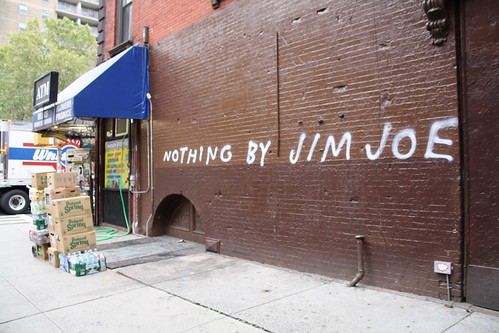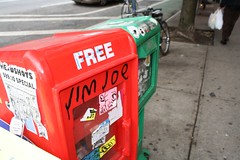 Maya MillettThe graffiti artist Jim Joe is known both for his ubiquity and the simplicity of his style.
Maya MillettThe graffiti artist Jim Joe is known both for his ubiquity and the simplicity of his style.If you’ve walked around the East Village lately, chances are you’ve seen two words set in a declarative scrawl on the grit of concrete: JIM JOE.
His presence within the neighborhood is virtually everywhere — there’s JIM JOE written on the side of a building on the Bowery; JIM JOE written in chalk on a dumpster on East Fourth Street and Avenue A — yet his ubiquity and deft use of social media to promote his projects have helped him cultivate an aura of mystery and elusiveness beyond that of many other taggers.
“I MISS YOU BUT I CANNOT BEAR TO LOOK YOU IN THE EYES,” he wrote in an e-mail exchange with The Local, one of his rare responses to requests for comment from the public. “I WOULD PREFER NOT TO BE SEEN.”
The Montreal-born graffiti artist known only as Jim Joe has generated much buzz since he reportedly entered the New York City street art scene earlier this year. Characterized by his unique mix of simple lettering coupled with his use of unconventional surfaces like discarded sofas and doors, Jim Joe has ensured that his work cannot be easily overlooked. He alternates between clean print and loopy cursive, and often accompanies his signature with humorous, often self-deprecating phrases like, “Jim Joe is the wurst” and “Not long is how long this tag took me.”
Jim Joe has built his persona on secrecy. But unlike most graffiti artists who do the same, Jim Joe uses social media to elevate his mystique and provide a far-reaching platform for his art. Through his public Twitter account and website Jim Joe has created an online presence fueled by curious onlookers and fans who are granted access into his world, yet are kept at a safe distance through the anonymity the Internet provides.
“He’s a bit of a cult figure around Montreal,” says 22-year-old Leah Pires, who first published photos of Jim Joe’s tags in McGill University’s art magazine, “Folio,” in the fall of 2009.
“He commands a level of respect that not a lot of graffiti artists have,” Ms. Pires says. “When I put him in “Folio” people thought, ‘Whoa, that’s really big’.”
While his mystery and the pervasiveness of his work comprise much of the fascination surrounding Jim Joe, Ms. Pires says that it was the artist’s creative way with words that earned him a space in the magazine. She mentions Jim Joe’s tendency to write on objects so that his phrases and the surface act in a kind of dialogue with each another. “It’s a clever arrangement of things,” Ms. Pires says. “I think it’s a lot more clever than a lot of graffiti artists you see.”
 Maya Millett In spaces low, high and in between, the tags of Jim Joe seem ever-present in the East Village.
Maya Millett In spaces low, high and in between, the tags of Jim Joe seem ever-present in the East Village.Reachable only via email, Jim Joe speaks in riddles and all capital letters. Asked to cite his primary influences, Jim Joe names French artist Marcel Duchamp. Mr. Duchamp is well-known for his “Readymade” pieces — art created by taking ordinary objects and configuring them into art through repositioning, reframing — or even signing them. Asked via email if he had any additional influences, Jim Joe writes:
TEENAGERS GAVE ME FREEDOM
GARBAGE GAVE ME A SURFACE
PAINT GAVE ME SOMETHING TO DO
AND BASQUIAT GAVE ME A FEW DOLLARS
Graffiti blogger Jowy Romano was given a similar roster of muses when he petitioned Jim Joe for an interview for his own site, Subway Art Blog. Mr. Romano says he became fascinated by — and a little obsessed with — Jim Joe after seeing his “1-800-JIM-JOE GOT ISSUES?” tag at the Essex Street subway station in February. Impressed by the artist’s website and intrigued by his ubiquity, Mr. Romano embarked on what would become a months-long research project into Jim Joe’s work.
“He draws influence not directly from other graffiti artists,” Mr. Romano says. “He ignores the unwritten laws of wild style — which is 99 percent of the graffiti you see now — and goes back to simpler styles, like most of the graffiti in the early ‘70s.”
Mr. Romano says he is most struck by the simplicity and structure of Jim Joe’s writing, describing the artist’s design sense as typographical. “He fills space like it’s a newspaper — like it’s a page.”
While skeptics may question whether the person behind Jim Joe’s Internet curtain is really the artist himself, the tagger has already won the upper hand by generating curiosity at all — and he wants us to know that he means business:
YOU CANT BE SERIOUS
OH BUT I AM SERIOUS
SERIOUSLY
SERIOUSLY
YOU DONT LOOK THAT SERIOUS
BUT I AM SERIOUS
HOW SERIOUS
VERY SERIOUS
SINCEARLY
JIM JOE





